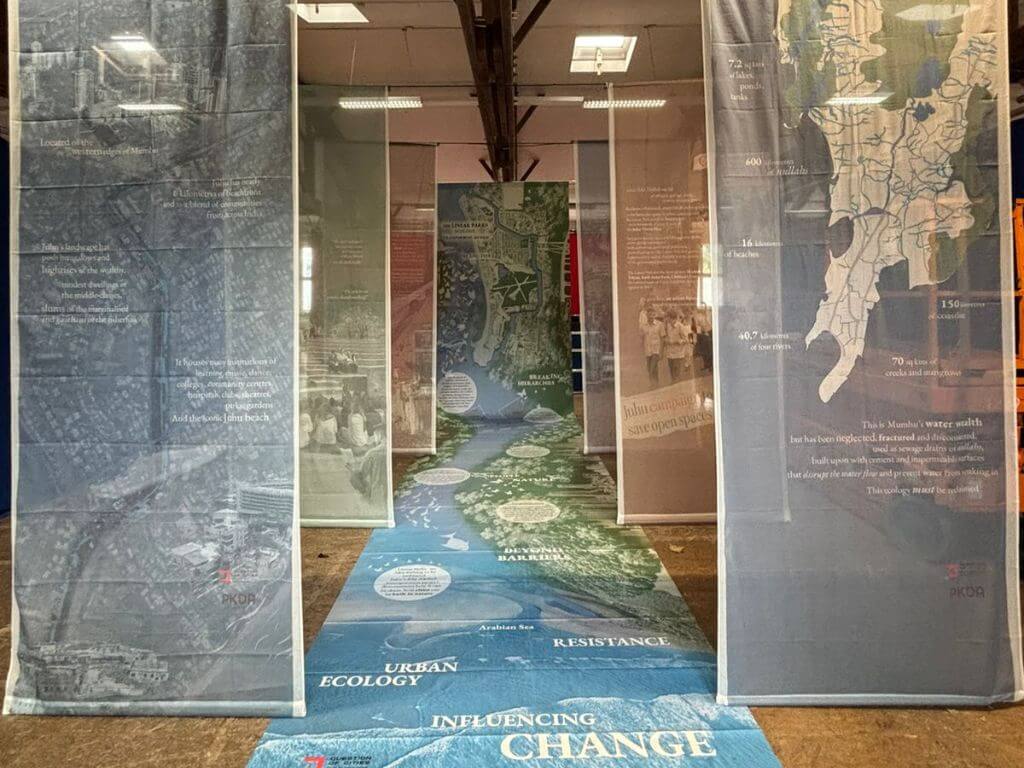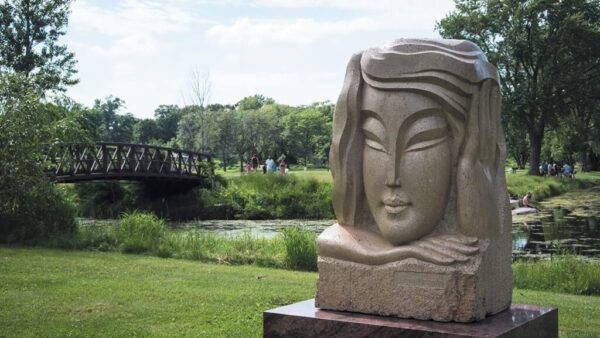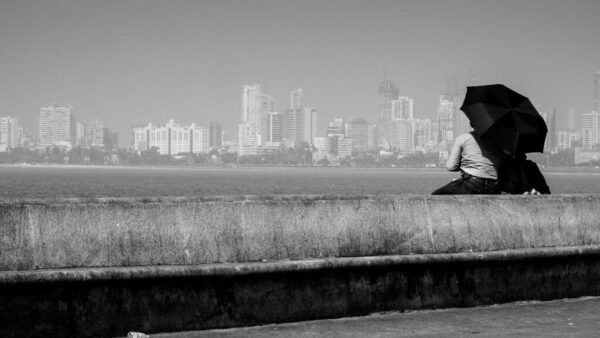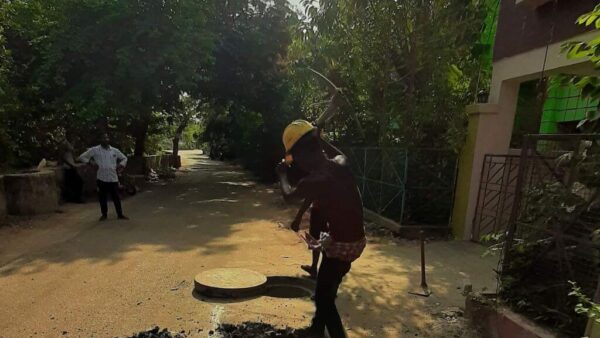Linear parks are what congested and polluted cities need. Besides providing long stretches of open and green spaces for walking, cycling and other leisure activities, they help in rejuvenating less-acknowledged urban spaces such as streams, canals and drains, roadsides, defunct railway lines, unused parking lots, spaces between buildings, public squares and more. Linear parks are also powerful climate warriors as cities record high temperatures and see unprecedented floods. And they help connect various natural areas fragmented by construction. Cities around the world that embraced the idea are reaping the benefits.
Mumbai has a linear park, a pilot project completed in 2017-18 that should have the city administration adopting the concept but this is not even on the table of the Brihanmumbai Municipal Corporation (BMC). Mumbai’s linear park was made by a group of citizens – professionals and activists – along a 1.2-kilometre stretch of the Irla Nullah in Juhu. The group agitated with the BMC, prevented land around the nullah from being usurped by a builder, and channelled the funds of the then Member of Parliament into the cleaning and renewing the nullah before making the linear park.
When it opened, the linear park, and the three gardens along the length of the nullah with an amphitheatre in one of them, offered people accessible open space for walking, cycling, jogging, reading, theatre and music activities, community gathering space and more. With the BMC withdrawing from cleaning the nullah, the linear park has had to be kept shut for the last year or so.
Linear parks are more than public spaces or mere manifestations of the now-popular blue green infrastructure. At the larger societal level, linear parks revive the ecology of cities across their length and breadth as well as nurture a democratic and participatory political atmosphere. When made along natural areas such as rivers and drains, or old ‘brown’ infrastructure like railway lines and roads, they contribute to the regeneration of nature, provide neighbourhoods with lush green zones, nurture biodiversity, and create open spaces for people. By their character of meandering along physical infrastructure, they connect neighbourhoods and, therefore, people across the neighbourhoods too promising community and democratic bonds.
“Linear parks are a metaphor for connecting people and also for connecting nature and people – a relationship that has been fragmented and segregated over the decades as cities were expanded with more construction. The idea is also to de-barricade spaces,” says PK Das, architect-activist, who conceived and designed the Irla Nullah project in collaboration with the National Environmental Engineering Research Institute and the Indian Institute of Technology-Bombay.
Mumbai, a city with nearly 300 kilometres of watercourses – comprising rivers, streams, lakes, nullahs, wetlands, mangroves – offers plenty of opportunities to build flourishing linear parks. They can also help make the city more inclusive by opening up spaces for social connections and interpersonal or community interactions. “We don’t need to grab or demolish areas for linear parks; they can be made in multiple marginal spaces connecting the city, which are considered ‘leftover’ spaces,” says Das.
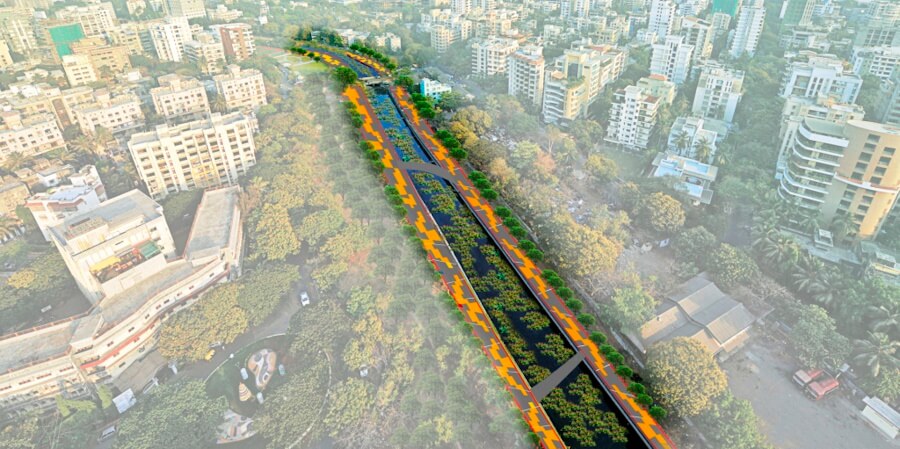
Illustration: PKDA Architects
From Juhu to Berlin
The Irla Nullah project story travelled to Berlin where it was showcased by Question of Cities and PKDA at the prestigious The Nature of Cities Festival, the international event which brought together environmentalists, planners and artists from across the world to reflect on ecologically sustainable cities and communities. The installation titled “The Linear Parks Ecology – Transforming Mumbai” was a set of large panels bringing alive the story of how the nullah was transformed, what it meant to Juhu, how Mumbai can be transformed. Illustrated by architect-visualiser Shivani Dave and architect Nikhil Kalambe, the panels drew admiration at the Berlin Festival.
Mumbai’s substantial inventory of blue and green spaces lies neglected, fractured and disconnected, seen as replaceable with built grey infrastructure. An example is Mithi River[1] which resembles an open drain carrying waste and sewage to the sea. These spaces, when built upon, do not allow rainwater to seep in, causing flash floods. Mumbai’s residents have a meagre 1 square metre of open green space per person; the WHO recommendation is 9 square metres.
In Juhu, the land around the Irla Nullah which was once marked as a ‘city forest’ saw a builder chop down nearly 1,100 trees to make way for construction.[2] The nullah was full of effluents, garbage and sludge. The Gulmohar Area Societies Welfare group and Save Open Spaces (SOS) group agitated with the BMC, petitioned politicians, approached elected representatives, campaigned in the media, and persisted for a decade till the linear parks and gardens took shape.[3]
This struggle was reflected in the installation at Berlin. It comprised a main panel of 30 feet (length) x 6 feet (width), and six side panels each of 10×4 feet, all in fabric. The centre panel had a rendering of Juhu with the Irla Nullah flowing through it and meeting the sea. The panels on either side of it showed the following: Mumbai’s watercourses and forest areas, a neighbourhood profile of Juhu, people’s campaign, its chronicle in the media, the state of the nullah before the reinvigoration, and after with people using the green open spaces.
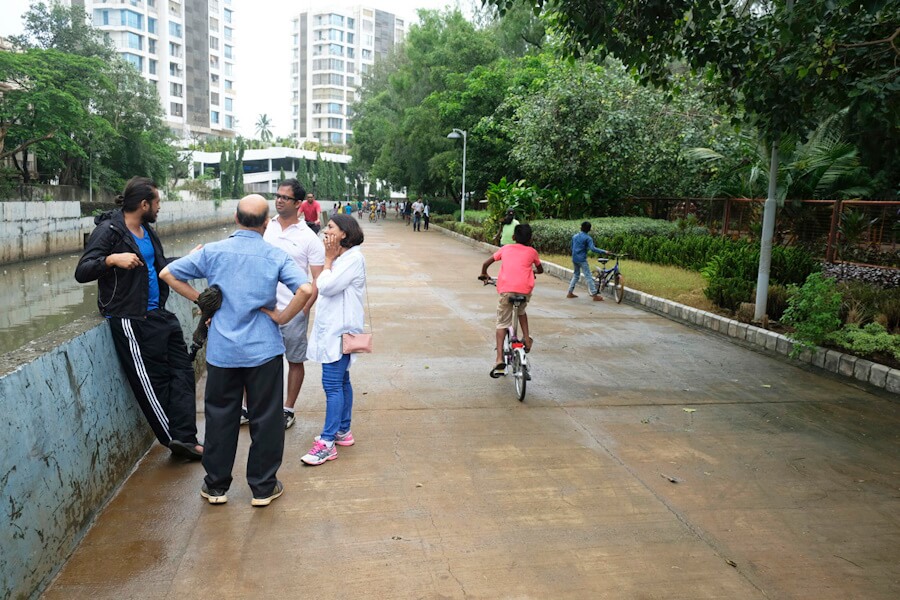
Photo: PKDA Architects
How Mumbai can be transformed
Linear parks can be along watercourses but equally threading other natural and built areas too. Mumbai has immense water wealth but its water bodies are fragmented and treated as dumping grounds. The potential to turn them into linear parks is immense; the Mithi riverfront, Sewri wetlands, Malad Creek are some neighbourhoods where linear parks can be initiated.
The total length of Mumbai’s major nullahs is nearly 261.5 kilometres and of its four rivers is 45-47 kilometres adding up to nearly 310 kilometres, according to BMC data. If both sides are developed into linear parks, it could give Mumbai an enviable 600 kilometres of open green spaces besides cleaner water bodies. Minor nullahs run along another 400 kilometres. If extended along arterial roads and old built infrastructure, linear parks would run into a hundred more kilometres.
The Irla Nullah project could have provoked a paradigm shift in the BMC in understanding Mumbai’s ecology and purposefully creating more green. It displayed community participation where residents not only pushed the parks and gardens idea but also supervised the nullah cleaning, prepared professional drawings for the linear park and gardens, and ensured public funds. “Every time we protested the cutting of trees, builders called our protests ‘wrong’. They were not afraid of authorities but we didn’t stop,” says Nita Bajpai, member of the Gulmohar Association. The then MP Javed Akhtar, resident of Juhu, gave from his funds.
Of the linear park, three gardens (Kishore Kumar Udyan, Kaifi Azmi Park, Children’s Forest) and the cultural space of Vijay Tendulkar Rang Manch, all are open for use except the linear park which is out of bounds till the BMC resumes cleaning of the nullah. This, residents’ groups say, will require another round of agitation and quiet work with civic officers. Ensuring a clean nullah and clearing its hard edges of debris, such as discarded cars from an unauthorised garage, can help Juhu in the monsoon.
As public spaces, linear parks with abundant trees are especially important in poorer neighbourhoods where, reports show, green open spaces tend to be fewer than in better-off areas. The linear parks ecology challenges this exclusion of people from green spaces. In this sense, linear parks are not merely about blue green infrastructure; they also open up spaces and make them accessible, therefore democratic too. Linear parks are an antithesis to the idea of a large central park.
Taken to neighbourhoods across Mumbai as a city-wide movement, the linear parks ecology has the potential to transform the city by substantially enhancing its green areas and biodiversity, providing accessible open spaces for people, and reconnecting people with nature.
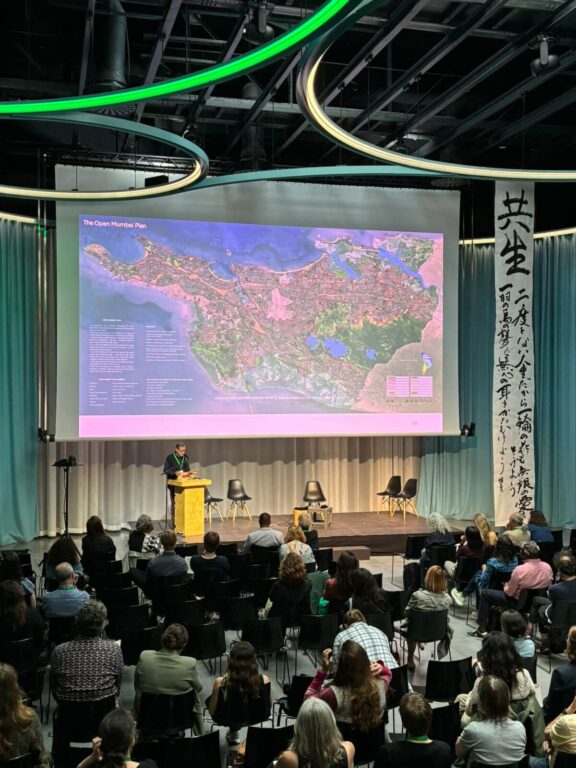
Photo: Samarth Das
Linear parks worldwide
After the Berlin debut, we plan to show the installation in Mumbai to initiate dialogues between people, planners, and the authorities. If the BMC adopts the idea, Mumbai would have joined an eclectic list of cities worldwide which effectively converted some of their in-between and unused spaces into thriving linear parks.
These include the Russian city of Kazan where the White Flowers Boulevard was made in 2018; New York’s The High Line, a 1.5–mile-long park built along an abandoned railroad in 2009, which turned controversial because of the unfortunate gentrification in some areas; the Bowline Park in Scotland which brought back into use the disused Bowling Viaduct; and the Hyperlane multilevel linear sky-park across green 2.4 kilometres in Chengdu, China. Read more in this compendium we published.[4]
Acknowledging the need for this is the first step. Linear parks can be imagined anywhere: natural areas, run down constructions, railway lines, industrial areas, old buildings, any vacant land. The concept can be applied across varying city geographies. The first documented one, in 1993 in Paris, was an abandoned 19th century viaduct converted into an elevated linear park and walkway, the Promenade Plantée, 10 metres above street level for nearly 4.8 kilometres. The Chicago Riverwalk reclaimed the meandering river for “the ecological, recreational and economical benefit of the city” with a thread of blocks each housing a museum, memorials, cafes, libraries, and commercial plazas.
Climate warriors
Linear parks play a silent but significant role in climate mitigation efforts which is often overlooked. The ‘brown infrastructure’ or construction is posited against blue green infrastructure though it should be led by nature. While construction is necessary, areas with abundant green are cooler and have cleaner air than areas where the brown dominates, anecdotal and empirical evidence shows.
When spread over a few kilometres, the green of linear parks helps lower ambient temperatures and purify air. Their permeable soil allows rainwater to soak into the earth helping to reduce the runoff thereby decreasing flooding and recharging the groundwater. Linear parks could be an important and affordable instrument in Mumbai’s climate action plan if the BMC were to adopt it. “Parks, especially linear parks, have ecological functions. They bring down temperatures, regulate flood vulnerability, help mitigate devastating impacts of cyclonic winds, create permeable surfaces, and help biodiversity to flourish,” Das points out.
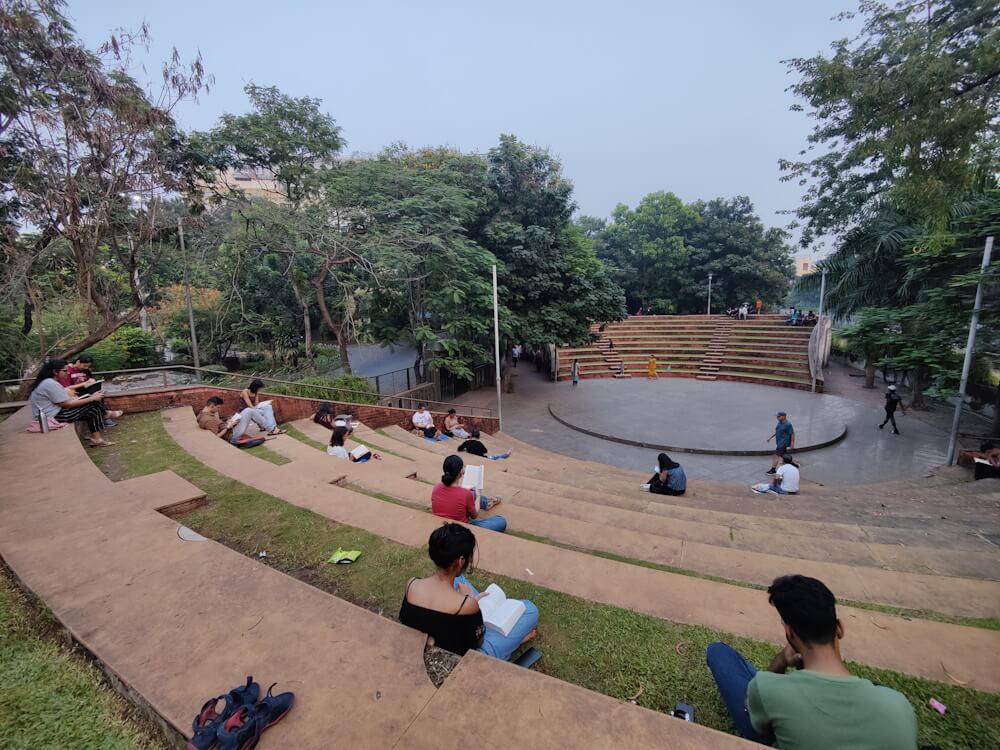
Photo: Shivani Dave
This summer, India hit record high across cities. The mere presence of trees in certain areas of cities lowered ambient temperature by 2-4 degrees Celsius, as documented in this essay in QoC.[5] The urban heat island effect increases heat stress in cities, with “notable physical and mental health implications for citizens”.[6]
The climate function is borne out internationally too. A study in Madrid showed summer temperatures 2.4 to 2.8 degrees Celsius lower in a park. A survey[7] of a linear park along an urban river in Cyprus found that on the hottest day, the maximum cooling effect of the park was 4.1 degrees Celsius. Urban forests help reduce daytime land and air temperature[8] via shading and transpiration.
Linear parks are also effective water management systems. Rampant construction means channelling rivers and streams with concrete walls (as in Mithi) or building on floodplains and wetlands. Climate change increases the risk of flooding but research[9] finds that “linear parks can take up a role in floodplain maintenance, function as recreation and wildlife corridors and reduce local floods”. By soaking surface runoff water in porous soil, they contribute to flood resilience. And they can remove up to 50 percent pollutants and 75 percent sediments from water.[10]
Green infrastructure can purify a city’s polluted air. Taiwan’s green parks reduced 21 percent of PM2.5 pollutants[11] while this study[12] found that particle removal by “dense forest canopies was observed to be over 30 percent higher than adjacent open heathland, with the greatest increases (over 50 percent) occurring at the forest edge”.
Linear parks are a step closer to designing biophilic cities or cities designed in a close relationship with nature. It is about seeing cities differently – and consciously building with nature.
Cover photo: The Question of Cities’ installation, ‘The Linear Parks Ecology – Transforming Mumbai’, in Berlin. Credit: Samarth Das

